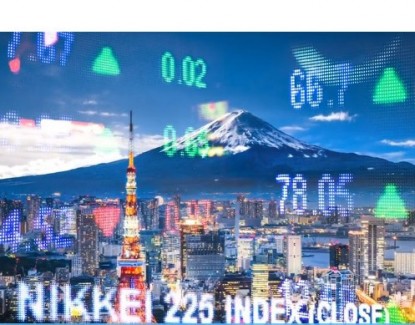Market Commentary and Fund Performance
Masa Takeda of Tokyo-based SPARX Asset Management Co., Ltd., sub-advisor to the Hennessy Japan Fund, shares his insights on the Japanese market and Fund performance.
-
 Masakazu Takeda, CFA, CMAPortfolio Manager
Masakazu Takeda, CFA, CMAPortfolio Manager
Fund Performance Review
In June, the Fund increased by 5.11% (HJPIX), outperforming its benchmark, the Russell/Nomura Total MarketTM Index, which rose by 3.67%.
The month’s positive performers among the Global Industry Classification Standard (GICS) sectors included shares of Industrials, Financials, and Information Technology while Health Care contributed negatively during the period.
Click here for full, standardized Fund performance.
Among the best performers were our investments in Mitsubishi Corporation, the largest trading company in Japan, Hitachi, Ltd., one of Japan’s oldest electric equipment & heavy industrial machinery manufacturers, and Mitsubishi UFJ Financial Group, Inc., one of Japan’s largest financial groups.
As for the laggards, Misumi Group Inc., the maker and distributor of metal mold components and precision machinery parts, Sony Group Corporation, diversified consumer and professional electronics, gaming, entertainment and financial services conglomerate, and Santen Pharmaceutical Co., Ltd., a pharmaceutical company specializing in ophthalmology, were the largest detractors.
In late May, we witnessed a rare proxy fight at one of the Fund’s portfolio holdings, Seven & i Holdings, Japan’s largest retail group/operator of the 7-Eleven convenience store chain. The shareholder campaign was led by the U.S. activist firm ValueAct which condemned in its open letters that the firm’s board is not functional, and the CEO is protecting his self-interest at the expense of the shareholders.
Before we dive into our views on the company’s management, we would like to make it clear that we generally credit them for building a very successful convenience store franchise in Japan over decades. A convenience store is a business of selling everyday items in convenient locations making it recession resistant, cash flow generative, and with high returns on capital (ROC). The retail format was born in the U.S. and has subsequently evolved in Japan. Ito-Yokado, a former Japanese retail group (known as Seven & i Holdings today), first brought the concept to Japan in the 1970s after signing a franchise agreement with Southland Corp., the original brand owner in the U.S. Thanks to the ingenuity of the president of Seven-Eleven Japan, Toshifumi Suzuki, at the time, the company went down its path to improve upon the business model and scale up to become the most powerful retailer in the country. Some of the past innovations include the use of the point-of-sale system, frequent same-day shelf replenishment, ready-to-eat meal offerings, private-label merchandise, etc. Seven-Eleven Japan became so successful that management ended up acquiring Southland Corp. (later renamed Seven-Eleven Inc.) when it declared bankruptcy in 1991. Today, the industry is concentrated in the hands of three dominant players in Japan, namely 7-Eleven, FamilyMart, and Lawson.
What we like about the company’s long-term prospects is its overseas growth potential. As of FY2022, about half of the group profit comes from the U.S., which is a result of the 2021 acquisition of Speedway, a rival convenience store (and gas station) chain. Seven & i have long been expanding its U.S. presence since 2006, mainly through mergers and acquisitions (M&As). With the Speedway deal, its U.S. store count became by far the largest in a still fragmented U.S. convenience store (CVS) industry.
The proxy fight: the U.S. activist firm demanded the replacement of four board members. While it is not certain whether these board members need to be replaced, we do believe there is room for improvement in several aspects as we will discuss below.
- Aside from its mainstay CVS business, Seven & i also operate low-margin ailing department store and superstore businesses. This has long been a drag on the group’s profitability. Despite the initial promise of realizing “group synergies,” it has not shown any meaningful improvement since the formation of the holding company in 2005. The department store business has been in the process of being sold to a private equity firm, but the deal negotiations have reportedly stalled. As for the superstore business, management is adamant about keeping the franchise within the group, but its poor financial performance is becoming increasingly hard to ignore (the segment consumes about 1,400bn yen/$10.1bn of total assets and produces only 10bn yen/$72.2mn in segment profit). The lack of decisiveness around restructuring is becoming intolerable for shareholders.
- As the domestic market has grown to saturation, Seven & i has been working on internationalizing their CVS operations for the next growth phase, especially in Southeast Asia where personal incomes are rising fast. However, the region’s contribution to the total earnings is almost non-existent even though 7-Eleven stores in Asia outnumber domestic ones by 2:1. This is because their Asian business is built around licensing contracts rather than a master franchise models. Under a typical licensing agreement, the headquarters grants the right to use the store brand, but the details of store layouts and operations are left to local operators’ discretion. This limited involvement results in only a small amount of licensing fees. In the contrary arrangement, the standard franchise agreements used in Japan require the franchisees to pay the headquarters anywhere between 40- 60% of store-level gross profits as royalty in return for various operational assistances. Such an arrangement is equivalent to 15-20% of store sales, a very profitable model. After a few decades of being in business, publicly listed area franchisees such as CP AlI PCL of Thailand and President Chain Store of Taiwan boast market cap of $17bn and $9bn, respectively, today. But alas, in neither of these companies does Seven & i own an economic interest. Thus, it has been a huge loss of opportunity for the Seven & i shareholders.
- According to ValueAct, in 2020, Seven & i allegedly received an acquisition proposal from an “overseas retail company.” This was never made public, and the story initially was reported by a business magazine publisher, Toyo Keizai Inc., but the article has long been deleted online. If this was true, it means that the shareholders were denied the opportunity to weigh the option of potentially selling their shares at a premium. So far, management has not addressed this topic in their response to the ValueAct’s open letter. The shareholders deserve a full explanation.
- In its April 18 rebuttal statement against ValueAct titled, “Our Board of Directors’ Opinion on the Shareholder Proposal,” Seven & i management self-praised that the group’s enterprise value to earnings before interest, taxes, depreciation, and amortization ratio (EV/EBITDA) multiple had increased from 4.3x to 7.5x thanks to the Speedway acquisition as if the company has created shareholders’ value significantly. This might be misleading, and in our view, the multiple expansion was mainly driven by the increase in net debt of about 2.4tn yen ($17.3bn)1 for the completion of the acquisition, which sharply raised the enterprise value (the numerator). On the contrary, the group’s price to earnings (P/E) multiple has de-rated from <20 times during FY2005-2019 to low teens post the acquisition (based on net profit (NP) before goodwill amortization).
- Acknowledging that they were too naïve in their past overseas expansion, the company has recently revealed a plan to grow its store network in untapped markets. As a pilot case, management is targeting Vietnam to deepen its involvement with a local franchisee, who operates 79 stores as of FY2022, with a mid-term target of 500 stores by FY2028. While the new ambition is commendable, we believe they need to step up their efforts. The very thing that the franchise business model enables you to do is speedy new store roll-out (the franchiser offers an established template for store operations with proven product offerings and brand recognition). By comparison, year after year the world’s biggest franchises such as McDonalds, Burger King, and KFC are opening new stores in multiple countries/regions. After missing out on the rapid penetration of 7-Eleven stores in most major Southeast Asian countries, management should not repeat the same mistake.
Despite these shortcomings, there are things to be excited about in Seven & i’s long-term prospects.
For example, as ValueAct points out, and we agree, that Seven & i have the chance to become the global retail champion. After all, Seven-Eleven is one of the best-known retail brands in the world with over 78,000 stores2, bigger than McDonald’s (40,000+stores) and Starbucks (35,000+stores). But 7-Eleven stores are present in only 18 countries. Its competitor Alimentation Couche Tard (ATD CN) is arguably the second largest CVS operator, and their operational metrics and track record is superior to Seven & i.
However, it is never too late to improve, and the U.S. alone should provide a significant growth runway. According to Grand View Research, the U.S. CVS industry is $884bn in size (as of 2020) and is still very fragmented. After the Speedway acquisition, Seven & i is the biggest with about 9% share (approximately 13,000 stores out of 150,000 stores nationwide).2 Assuming the company can increase its share to 20% organically (as well as inorganically, with many roll-up deals are possible) then its U.S. system-wide revenue could reach as much as $177bn ($884bn x 20%) or 24.8tn yen. Assuming a 2.5% net margin (FY2022 net profit margin (NPM) was 2.6%. Walmart has roughly 3% NPM), net profit will amount to more than 600bn yen ($4.3bn) (24.8tn yen/$179.1bn x 2.5% NPM) from the U.S. alone. Of course, the company needs to tackle the issue of the gasoline station business which will inevitably shrink due to growing electric vehicle (EV) penetration, but it should be offset by the growing proportion of higher margin merchandise sales such as fresh food, private label products, etc. Furthermore, the fuel business will not disappear overnight. The share of registered EVs in the U.S. is still only 0.5% (as of Dec 2021). It will take years for EVs to completely displace traditional internal combustion vehicles. Meanwhile, Seven & i and other incumbents are expected to benefit from this oligopolistic industry where a new player’s entry is highly unlikely. Also, if the gasoline station business starts to decline across the industry, the small players (60% of the industry players have less than 10 stores) will likely suffer the most due to their lack of scale. This should accelerate the industry consolidation in favor of Seven & i.
In terms of valuation, Seven & i adopt J-GAAP for its financial disclosures, which means periodic goodwill amortization is mandatory regardless of whether or not there are impairment risks. For this reason, the company’s reported earnings per share (EPS) is approximately 40% lower than EPS “before goodwill amortization.” As a cash-based thinker, we use EPS estimate before goodwill amortization of 450 yen ($3.25) to value the stock, which will yield a P/E multiple of 13.8x versus 19.2x the reported EPS.2 This is also below the market average.
On an EV/EBITDA basis, its multiple has risen after the Speedway acquisition owning to higher debt levels as mentioned above. But even at the elevated multiple of 8x today, Seven & i trade at a discount to ATD CN’s 11x EBITDA.1 One caveat is that the company changed its leasing accounting in FY2022, whereby operating lease obligations are now fully reflected on the balance sheet as liabilities. This has inflated its EBITDA by roughly 80bn yen ($577.9mn) based on our estimate to 995bn yen/$7.2bn (lease payment as a selling, general and admin cost is now accounted for as depreciation and interest payment on profit and loss). Had it not been for this accounting change, actual EBITDA would have been lower and EV/EBITDA somewhat higher, but the stock would still be cheaper than ATD CN.
Another valuation approach is free cash flow yield. In FY2022, the company generated 928bn yen ($6.7bn) in operating cash flow and had investing cash outflow of 413bn yen ($3.0bn), which translates into free cashflow of 515bn yen ($3.7bn). Hence, the free cash flow yield is around 9.4% free cash flow (FCF)/market cap, substantially higher than the 10-year risk-free rates. Even if you strip out the financial services segment-related cash flows (i.e., net increases in customer deposits and overnight call loans shown in CFO), the FCF would be well above 400bn yen ($2.9bn), still making the valuation appear inexpensive. In the FY2022 earnings presentation, management guides for FCF ex-financial services of 500+bn yen ($3.6+bn) by FY2025. We believe this is achievable.
Lastly, we have not discussed the outcome of the proxy battle: At the annual shareholders meeting on May 25, the shareholder proposals put forward by ValueAct failed to win the vote. But it was not a complete defeat, in our view. The key incumbent directors’ (i.e., CEO Isaka, Executive Vice President Goto, etc) approval ratings fell sharply to 65%-76% from above 90% a year ago. Considering this, we believe ValueAct did a great job of bringing to light the shareholders’ concerns over the current management, and their execution capabilities will now be under scrutiny. This, in turn, should raise the awareness of the management team going forward.
Click here for a full listing of Holdings.
- In this article:
- Japan
- Japan Fund
1 Source: Bloomberg
2 Source: Company website/presentation
You might also like
-
 Portfolio Perspective
Portfolio Perspective
Japan FundJapan’s Evolving Investment Landscape in 2025
 Masakazu Takeda, CFA, CMAPortfolio Manager
Masakazu Takeda, CFA, CMAPortfolio Manager Angus Lee, CFAPortfolio Manager
Angus Lee, CFAPortfolio Manager Kohei MatsuiPortfolio ManagerRead the Commentary
Kohei MatsuiPortfolio ManagerRead the CommentaryIn the following commentary, the Hennessy Japan Fund Portfolio Managers summarized what most surprised them in 2024 about the Japanese market along with positive trends driving Japanese companies.
-
 Investment Idea
Investment IdeaCompelling Valuations in Japan
 Masakazu Takeda, CFA, CMAPortfolio Manager
Masakazu Takeda, CFA, CMAPortfolio Manager Tadahiro Fujimura, CFA, CMAPortfolio Manager
Tadahiro Fujimura, CFA, CMAPortfolio Manager Takenari Okumura, CMAPortfolio ManagerRead the Investment Idea
Takenari Okumura, CMAPortfolio ManagerRead the Investment IdeaJapanese equities are currently trading at compelling valuation levels compared to other developed equity markets around the world and relative to their own historical averages. We believe the Japanese market deserves a closer look.
-
 Investment Idea
Investment IdeaWhy Active Matters When Investing in Japan
 Masakazu Takeda, CFA, CMAPortfolio Manager
Masakazu Takeda, CFA, CMAPortfolio Manager Angus Lee, CFAPortfolio Manager
Angus Lee, CFAPortfolio Manager Kohei MatsuiPortfolio Manager
Kohei MatsuiPortfolio Manager Tadahiro Fujimura, CFA, CMAPortfolio Manager
Tadahiro Fujimura, CFA, CMAPortfolio Manager Takenari Okumura, CMAPortfolio ManagerRead the Investment Idea
Takenari Okumura, CMAPortfolio ManagerRead the Investment IdeaWhen investing in Japanese businesses, we believe it is imperative to select a manager who is immersed in the culture and can perform in-depth, company-specific research to build a concentrated portfolio of Japanese companies that can outperform a benchmark and weather volatility.
